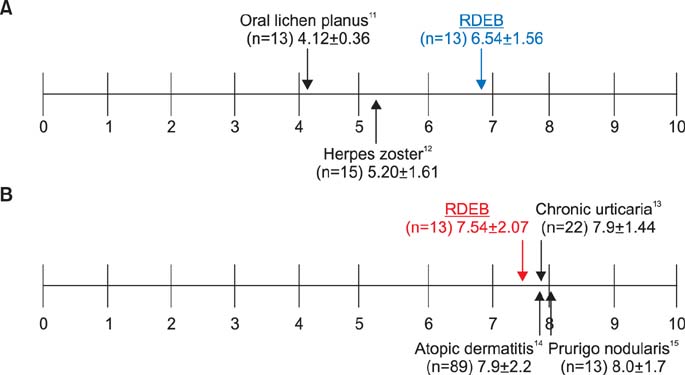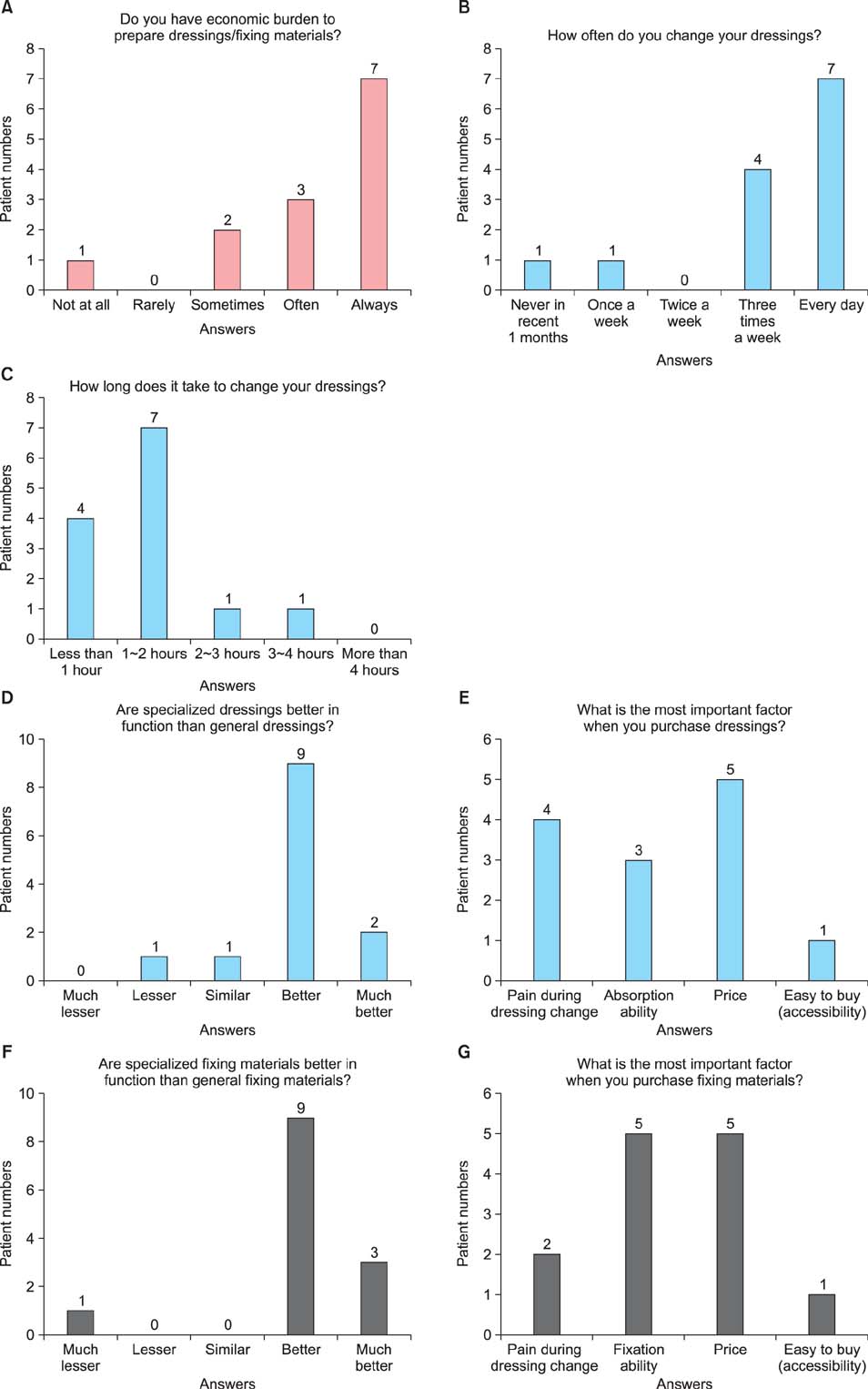Ann Dermatol.
2016 Feb;28(1):6-14. 10.5021/ad.2016.28.1.6.
Quality of Life and Economic Burden in Recessive Dystrophic Epidermolysis Bullosa
- Affiliations
-
- 1Department of Dermatology, Gangnam Severance Hospital, Cutaneous Biology Research Institute, Yonsei University College of Medicine, Seoul, Korea. kimsc@yuhs.ac
- KMID: 2429476
- DOI: http://doi.org/10.5021/ad.2016.28.1.6
Abstract
- BACKGROUND
Patients with recessive dystrophic epidermolysis bullosa (RDEB) exhibit blisters and erosions since birth, causing pain, pruritus and various complications. RDEB affects quality of life (QoL) in physical, emotional and social aspects. Furthermore, interminable dressing changes and supportive therapies impose a significant economic burden on the patient's family.
OBJECTIVE
We assessed the QoL and economic burden in patients with RDEB.
METHODS
Sixteen patients with RDEB were surveyed to assess the QoL and economic burden. Patients answered questionnaires consisting of a visual analogue scale (VAS) on pain and pruritus, Skindex-29, Quality of Life in EB questionnaire (QOLEB), and the economic burden due to EB.
RESULTS
Thirteen patients with RDEB completed the questionnaire. Female patients presented higher VAS, QOLEB and total Skindex-29 scores than male patients. Patients with RDEB showed severe levels of pruritus, which was more intolerable than pain. Mean VAS score on pain in RDEB was higher than in oral lichen planus and post-herpetic neuralgia. VAS score on pruritus was similar to those in chronic urticaria, atopic dermatitis, and prurigo nodularis. Compared with other dermatologic conditions, patients with RDEB were profoundly affected in all three scales of skindex-29. Mean "medical cost" in a month was $257.54 (USD) (+/-169.39) and mean "dressing cost" was $358.41 (USD) (+/-312.55), which was negatively related to patient age.
CONCLUSION
RDEB had a profound impact on QoL and economic burden. Compared with other dermatologic diseases, RDEB showed severe symptoms and QoL was seriously impaired. Most patients sustained economic burdens, especially on preparing dressing materials. Younger patients experienced more economic burdens.
MeSH Terms
Figure
Reference
-
1. Fine JD, Bruckner-Tuderman L, Eady RA, Bauer EA, Bauer JW, Has C, et al. Inherited epidermolysis bullosa: updated recommendations on diagnosis and classification. J Am Acad Dermatol. 2014; 70:1103–1126.
Article2. van Scheppingen C, Lettinga AT, Duipmans JC, Maathuis CG, Jonkman MF. Main problems experienced by children with epidermolysis bullosa: a qualitative study with semi-structured interviews. Acta Derm Venereol. 2008; 88:143–150.
Article3. Frew JW, Murrell DF. Quality of life measurements in epidermolysis bullosa: tools for clinical research and patient care. Dermatol Clin. 2010; 28:185–190.
Article4. Frew JW, Martin LK, Nijsten T, Murrell DF. Quality of life evaluation in epidermolysis bullosa (EB) through the development of the QOLEB questionnaire: an EB-specific quality of life instrument. Br J Dermatol. 2009; 161:1323–1330.
Article5. Tabolli S, Sampogna F, Di Pietro C, Paradisi A, Uras C, Zotti P, et al. Quality of life in patients with epidermolysis bullosa. Br J Dermatol. 2009; 161:869–877.
Article6. Wagner JE, Ishida-Yamamoto A, McGrath JA, Hordinsky M, Keene DR, Woodley DT, et al. Bone marrow transplantation for recessive dystrophic epidermolysis bullosa. N Engl J Med. 2010; 363:629–639.
Article7. Conget P, Rodriguez F, Kramer S, Allers C, Simon V, Palisson F, et al. Replenishment of type VII collagen and re-epithelialization of chronically ulcerated skin after intradermal administration of allogeneic mesenchymal stromal cells in two patients with recessive dystrophic epidermolysis bullosa. Cytotherapy. 2010; 12:429–431.
Article8. Pagliarello C, Tabolli S. Factors affecting quality of life in epidermolysis bullosa. Expert Rev Pharmacoecon Outcomes Res. 2010; 10:329–338.
Article9. Lundqvist C, Benth JS, Grande RB, Aaseth K, Russell MB. A vertical VAS is a valid instrument for monitoring headache pain intensity. Cephalalgia. 2009; 29:1034–1041.
Article10. Reich A, Heisig M, Phan NQ, Taneda K, Takamori K, Takeuchi S, et al. Visual analogue scale: evaluation of the instrument for the assessment of pruritus. Acta Derm Venereol. 2012; 92:497–501.11. Mansourian A, Momen-Heravi F, Saheb-Jamee M, Esfehani M, Khalilzadeh O, Momen-Beitollahi J. Comparison of aloe vera mouthwash with triamcinolone acetonide 0.1% on oral lichen planus: a randomized double-blinded clinical trial. Am J Med Sci. 2011; 342:447–451.
Article12. Park J, Jang WS, Park KY, Li K, Seo SJ, Hong CK, et al. Thermography as a predictor of postherpetic neuralgia in acute herpes zoster patients: a preliminary study. Skin Res Technol. 2012; 18:88–93.
Article13. Aydogan K, Karadogan SK, Tunali S, Saricaoglu H. Narrowband ultraviolet B (311 nm, TL01) phototherapy in chronic ordinary urticaria. Int J Dermatol. 2012; 51:98–103.
Article14. Chrostowska-Plak D, Reich A, Szepietowski JC. Relationship between itch and psychological status of patients with atopic dermatitis. J Eur Acad Dermatol Venereol. 2013; 27:e239–e242.
Article15. Ständer S, Siepmann D, Herrgott I, Sunderkötter C, Luger TA. Targeting the neurokinin receptor 1 with aprepitant: a novel antipruritic strategy. PLoS One. 2010; 5:e10968.
Article16. Arenberger P, Arenbergerová M, Drozenová H, Hladíková M, Holcová S. Effect of topical heparin and levomenol on atopic dermatitis: a randomized four-arm, placebo-controlled, double-blind clinical study. J Eur Acad Dermatol Venereol. 2011; 25:688–694.
Article17. Nijsten T. Dermatology life quality index: time to move forward. J Invest Dermatol. 2012; 132:11–13.
Article18. Ahn BK, Lee SJ, Namkoong K, Chung YL, Lee SH. The Korean version of skindex-29. Korean J Dermatol. 2004; 42:9–15.19. Ahn BK, Lee SJ, Namkoong K, Chung YL, Lee SH. Quality of life of acne patients. Korean J Dermatol. 2005; 43:6–14.20. Ryu JH, Kim KH, Kim KJ, Kim SJ. Quality of life in patients with psoriasis. Korean J Dermatol. 2004; 42:264–271.21. Han SH, Byun JW, Lee WS, Kang H, Kye YC, Kim KH, et al. Quality of life assessment in male patients with androgenetic alopecia: result of a prospective, multicenter study. Ann Dermatol. 2012; 24:311–318.
Article22. Klein R, Moghadam-Kia S, Taylor L, Coley C, Okawa J, LoMonico J, et al. Quality of life in cutaneous lupus erythematosus. J Am Acad Dermatol. 2011; 64:849–858.
Article23. Sampogna F, Picardi A, Chren MM, Melchi CF, Pasquini P, Masini C, et al. Association between poorer quality of life and psychiatric morbidity in patients with different dermatological conditions. Psychosom Med. 2004; 66:620–624.
Article24. Fine JD, Johnson LB, Weiner M, Suchindran C. Assessment of mobility, activities and pain in different subtypes of epidermolysis bullosa. Clin Exp Dermatol. 2004; 29:122–127.
Article25. Pope E, Lara-Corrales I, Mellerio J, Martinez A, Schultz G, Burrell R, et al. A consensus approach to wound care in epidermolysis bullosa. J Am Acad Dermatol. 2012; 67:904–917.
Article



